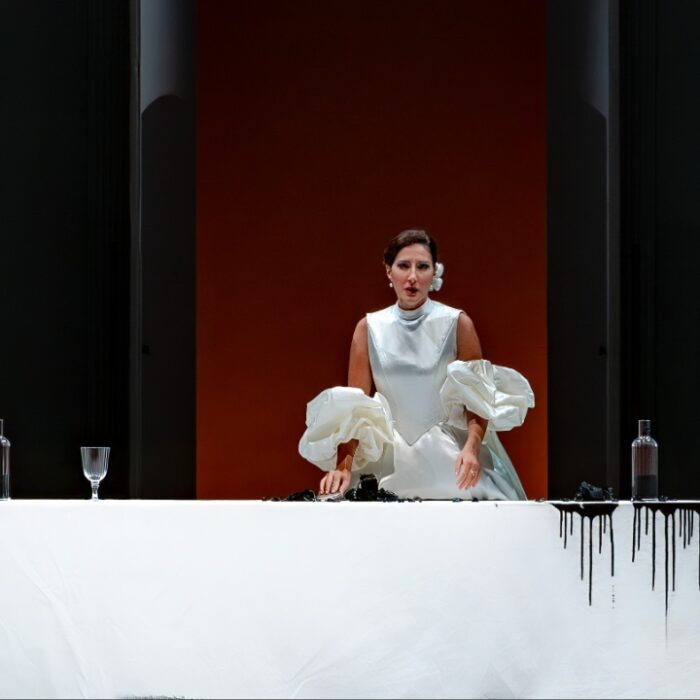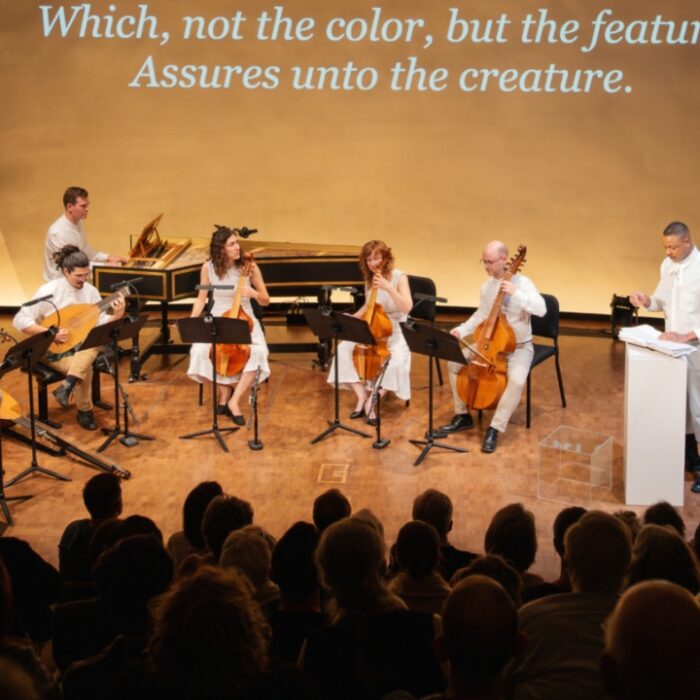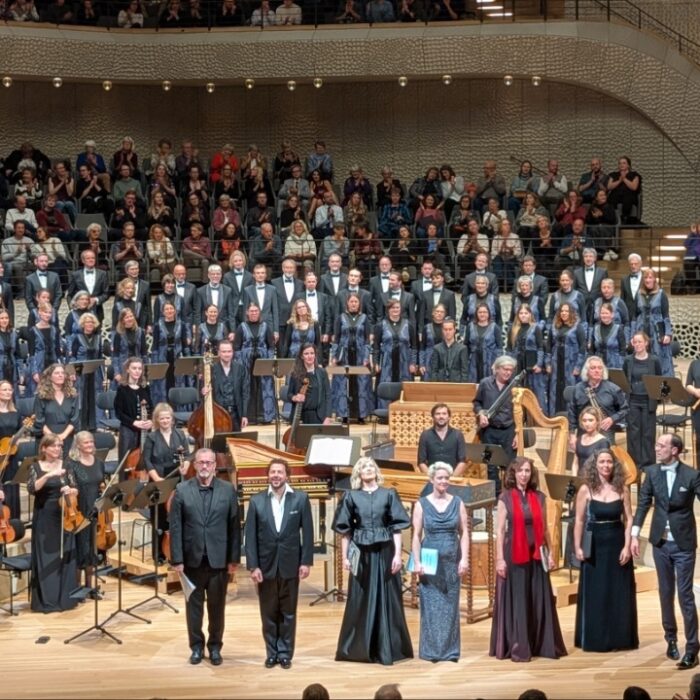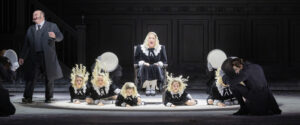
Metropolitan Opera 2024-25 Review: Salome
Elza van den Heever Commits to Strauss’ Work in Disappointing & Dull New Production
By Francisco Salazar(Credit: Evan Zimmerman / Met Opera)
On April 28, 2025, the Metropolitan Opera opened a new production of Strauss’ “Salome.”
At the center of the highly anticipated performance was the debut of internationally-renowned director Claus Guth, who has built a name of edgy reimaginings of classic works. It was also the first new production of “Salome” at the Met since 2004. The production starred Elza van den Heever, who astonished audiences in Paris with her turn as the legendary princess and who this past fall created a sensational turn in “Die Frau ohne Schatten” on the Met’s hallowed stage.
All the pieces seemed to be in place for what should have been a riveting evening. It didn’t quite live up to the hype.
Dull & Disconnected
Guth’s calling card is a penchant for provocation. At his best, he electrifies with concepts that are outrageous but often stay with you. At his lowest points, the concepts are tame and dull.
For this production, Guth set the opera in the Victorian era, a time of repression and prudishness. For his concept, he was interested in showing how Salome is affected by this period and how, from an early age, she was abused. In the opening images of the production, you see a little girl playing with a doll that she quickly goes on to destroy. Then, as she enters, she is dressed in a black dress with a high neckline that emphasises the repressed state that she lives in. Only when she enters the cistern where Jochanaan is imprisoned does she strip into a white dress as a symbol of breaking free. This location is interesting as well because of how it features children’s toys, making Jochanaan a symbol for her lost and traumatized childhood. In a way, her yearning for him is a yearning for that lost childhood that is forever trapped in a dark basement.
When she returns to the palace, she returns to her black, restrictive dress. Guth further emphasizes this in his production through the Dance of the Seven Veils as various younger versions of Salome begin to show different episodes of abuse that she tolerated as a younger girl. Only at the end of the dance does Salome finally break free as she kills the ram, which is a symbol of Herod and the abuse she has tolerated. And while those ideas are interesting, they don’t connect with Salome’s lust or necrophilic character at the end when she continuously asks for the head of Jochanaan. Guth says in his artistic statement that Salome is finding her way, but how is beheading a prophet finding her way, and how is she not stuck in the same cycle of her lustful and abusive stepfather? Perhaps ultimately, the abused can never break free from that abuse. The final scene with Jochanaan’s head seems to be some sort of confrontation and retrieval of a traumatized childhood.
But something was amiss. The symbols were clear. But the flow and cohesion with the dramatic action was where the main issues resided.
The production is set in a huge black Victorian palace with intricate sculptures and stairs, and the lower part, as the stage rises, is a white chalk cistern. It’s minimalist and monochromatic and could be incredibly effective. But Guth does nothing with the direction, as he has a bunch of people standing and sitting around for ample bunches of time. Once in a while, menacing figures walk around in ram masks and terrorize a naked woman who appears and disappears. It’s quite disappointing considering that in most regietheater productions, distracting stage action is at a premium and while it’s often to the detriment, it always lends some layer of interest or meaning. In other words, it’s rarely boring. But here, with some rather static moments, it often is.
Salome destroys a statue of a ram, which emphasizes her breaking free of the patriarchy, and the stage moves up and down to give it some dynamism. Herodias constantly asks for a new drink while Herod only walks on carpets that his servants constantly put on the floor for him. But ultimately, these directional flashes are just that, ideas with no clear definition or development. It makes for a tiresome and dull evening. And there is some clunkiness in the blocking, like Salome putting on her dress to open the Dance of the Seven Veils and putting Jochanaan’s head on a stake. On this evening, the dress just didn’t seem to want to go on, and Elza van den Heever couldn’t quite get the head on the stake as she looked at the bottom of it to make sure she was doing it correctly.
His most innovative moment is the aforementioned Dance of the Seven Veils, which is a slow burn but poorly choreographed with the music. But once it finally gets to the climax, there is some violent imagery that shows promise for what the finale of the opera could be. Another interesting directional choice is Herodias’s costume, which is an orange dress that stands out from the black ones everyone else has. Here, Guth shows that she is an independent woman who breaks away from the norms of society and has paved her own way in life, even if it isn’t the moral one.
Guth’s debut at the Met was always going to be a question mark and Met audiences were mixed as there were scattered boos in the audience as he entered to take his curtain call.
Solid But Not Electrifying
In the pit, Yannick Nézet-Séguin was conducting his third Strauss opera at the Met following his lackluster “Elektra” and his rousing “Die Frau ohne Schatten.” On this evening, Nezet-Seguin was solid and predictable, drawing no electricity from the orchestra.
He drew solid colors from the ensemble, especially in the final scene, displaying the eeriness of the score. The chords in the string section before the final scene were piercing, almost as if a knife was scratching a surface. The final section of the finale, as Salome sings, “Ah! Ich habe deinen Mund geküßt, Jochanaan,” gave a demonic feel to Salome’s leitmotif coupled with the violin lines. The Dance of the Seven Veils was also memorable, even if the opening section was rocky and slow in many sections. Still, Nézet-Séguin captured the chaos in the piece with an emphasis on the percussion at the beginning and the lustful and irresistible middle melody with vibrant colors. The opening clarinet solo also gave a sense of mystery, and the interludes between scenes were performed with a sense of propulsion.
But overall, Nézet-Séguin’s conducting had numerous balance issues, especially with Elza van Den Heever, whom he covered numerous times in the opening and final scene, especially when she had to sing in her lower range. And then there was the final scene, which just felt like it constantly got slower and slower. As Van den Heever ended her final phrase, “Ich habe ihn geküßt, deinen Mund,” Nézet-Séguin held out the melody with the same dynamic, a forte that never really shifted to the piano. The effect was not electrifying but just predictable and lacking. Overall, for the Met’s music director, there seemed to be a lack of dramatic drive in the entire evening.
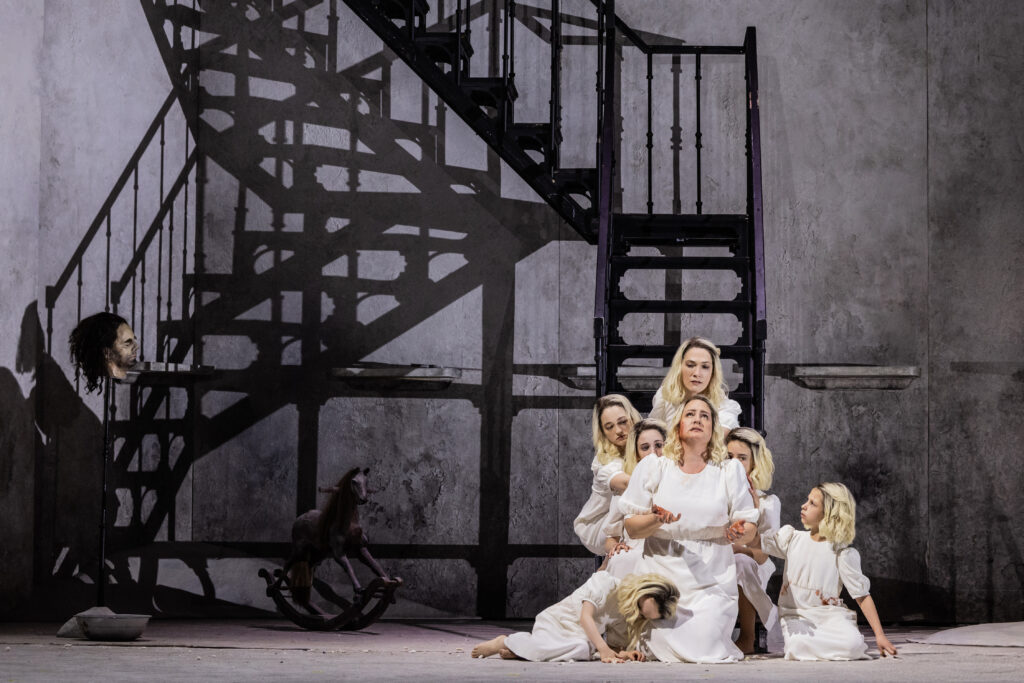
Evan Zimmerman / Met Opera
Committed Portrayal but Disconnected
The role of Salome is one of the most complex in the operatic repertoire, as it asks a soprano to play a 16-year-old while also singing some of the most dramatic lines ever written with an incredibly heavy orchestra. Not to mention, the soprano has to be on stage for almost two hours without ever taking a breather.
In the title role, Elza van den Heever gave a committed performance that showed all the facets of Salome from a young woman who slowly devolves through her lust-filled and necrophiliac desires for Jochanaan. When Van den Heever first entered the stage, there was still a sense of harmlessness in her Salome as she pranced and twirled around the stage, flirting with the soldiers. There was a sexual encounter as Narraboth attempted advances on her, but Van den Heever was still playful. Once Van den Heever’s Salome entered the Cistern and saw Peter Mattei’s Jochanaan, she was struck by him, and her desires started to awaken. The soprano’s movements started to become more aggressive toward Jochanaan as she attempted to kiss his lips. In her scene with Herod, Van den Heever’s Salome obtained a capricious and defiant attitude as she mocked Herod’s attempt at luring her to eat and drink. Her movements became more sexual. At one point, she graced her entire body erotically, and at another, she reclined on a chair and placed fruit at the bottom of her dress. Her encounters with Herod also became more aggressive, with Gerhard Siegel touching her body and Van den Heever becoming increasingly suggestive.
But it all climaxed in the final scene where Van den Heever was completely bewitched by Jochanaan. Her visage was completely blank as if a demon had possessed her. When she walked to Jochanaan’s body with the head, she lustfully sat on it. Van den Heever seemed to be completely aroused by the image of the beheaded body. It was captivating to watch the soprano as an actress as she completely took control of the 20-minute scene, and you couldn’t take your eyes off of her.
Vocally, it was a mixed bag as the soprano’s voice seemed to lose resonance in her lower parts of the voice, with the chest voice a bit hollow and the middle range seemingly unstable. The top register shone even if it was a bit metallic and lacked the shimmer that she has displayed in previous Met productions. That was particularly an issue in the opening phrases, which are recitative phrases that lie in the middle range and which were at times covered by the orchestra. In her final scene, which is a tour de force, Nézet-Séguin’s orchestra was out in full force, and the soprano could not compete with his loud sound, sometimes pushing her voice to the limit. As a result, the top sounded insecure. It was a herculean effort that didn’t quite ascend to the highest of peaks.
That being said, one has to admire the evolution of her voice throughout the two-hour run time. Van den Heever started her evening with a lighter sound, emphasizing the innocent aspects of Salome, and only started to let out her full voice when she met Jochanaan. Then in her scene with Herod and Herodias, Van den Heever played with her sound, giving her timbre a seductive feel as she rejected Herod’s offers. Her voice slowly evolved into desperation and obtained darker tones as she demanded the head of Jochanaan. And toward the end, Van den Heever combined the dramatic full voice as she rejoiced in kissing the head with eerie whispers. Her “Ah! Ich habe deinen Mund geküßt, Jochanaan” captured the possessed state of Salome with the slides in her voice sounding ghostly. And the final climactic repetition of “Ich habe ihn geküßt, deinen Mund” soared into the auditorium with power.
In the role of Jochanaan, Peter Mattei had an interesting evening. His first lines and last phrases are sung off stage. Those phrases, for some reason, sounded amplified, and the voice sounded hollow. However, when he was on stage in the scene with Salome, Mattei’s voice had a fierce resonance and a round timbre that emitted enormous sound into the Met auditorium. He portrayed Joachanaan with defiance even as he was trapped by the handcuffs, avoiding Van den Heever’s Salome. His voice steadily took on a gritty sound, especially as he cursed Salome, repeating the line “Du bist verflucht. Du bist verflucht” with ferocity. He eventually crescendoed to a fortissimo, pushing his voice to the limit. Mattei also gave his voice a darker and ominous color in such phrases as “!Zu ihr will ich nicht sprechen” and “Zurück, Tochter Babylons.” This helped emphasize his character’s defiance but also his terror of Salome’s potential sins.
Impeccable Performances
In the role of Herod, Gerhard Siegel used his tenor to great effect. At first, he came off as playful with his emphasis on text and diction. The grating nature of his voice showcased the lustful and abusive nature of his character. But as he became tormented by the winds, Siegel’s voice sounded more desperate, often pushing it into an unattractive vocal colors. During the advances on Salome, as he asked her to drink, “komm, trink Wein mit mir, einen” and eat, “komm, iß mit mir von diesen,” Siegel’s voice had a lecherous feel. Each time Van den Heever denied his advances, Siegel’s frustrated character obtained a more forceful sound. During the Dance of the Seven Veils, there was a moment where Siegel took the ram’s mask off, looking in horror as Salome killed the other ram. That horror only escalated as she demanded the head of Jochanaan. At first, Siegel phrased each line as if it were all a folly. But as the demand continued, Siegel sang with more desperate colors with each “Nein, nein” more staccato and his timbre more forced. It escalated into a horror-driven Siegel who, at the end, sang the phrases “Sie ist ein Ungeheuer, deine Tochter” telling Herodias what a monster she had created. Even as he demanded the murder of Salome, “Man töte dieses Weib!,” Siegel was tormented.
In the role of Herodias, Michelle DeYoung started a bit airy in her sound. But as she took control of her character, her voice contained a fuller, rounder edge. DeYoung started off the evening by playing Herodias with sarcasm and mocking her husband, Herod. Her rhythmic precision was evident, but as she became tormented by Jochanaan’s voice from a distance, DeYoung let out the full power of her voice, emphasizing her character’s agitation. In this production, as noted, one of the ways of showing her agitation and desperation was by continuously asking for a drink. But after Salome’s Dance, DeYoung’s character took back control as she looked proud of her daughter and mocked Gerard Siegel’s Herod. Even as she sang “Sie hat recht getan. Ich möchte jetzt hier bleiben” in the final scene, you knew that DeYoung’s Herodias got what she wanted, and perhaps Salome would be following in her footsteps.
In the role of Narraboth, Piotr Buszewski, sang his opening lines “Wie schön ist die Prinzessin Salome heute” with ardent and passionate colors. Each time he repeated the phrase, the voice gained more ardor. But as his character quickly realized Salome’s desire for Jochanaan, Buszewski’s voice took on a more tortured tone. His voice gained more weight, emphasizing the agony of not being able to win over Salome.
In the role of the Page, Tamara Mumford sang with solid phrasing, while the soloists portraying the Jews, led by Billie Bruley, Thomas Capobianco, Alex Boyer, Bernard Holcomb, and Robert Pomakov, performed with bright sound and were always well-synchronized.
“Salome” is an opera that rarely gets performed at the Met, and even though this was a disappointing evening, it is an experience that has to be seen.
